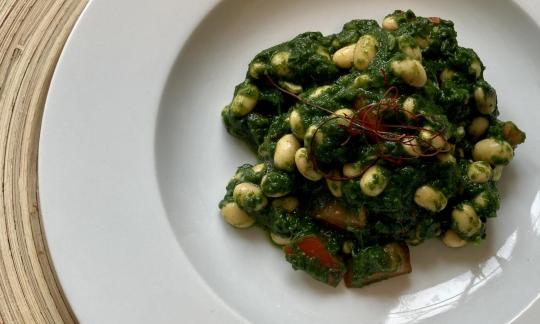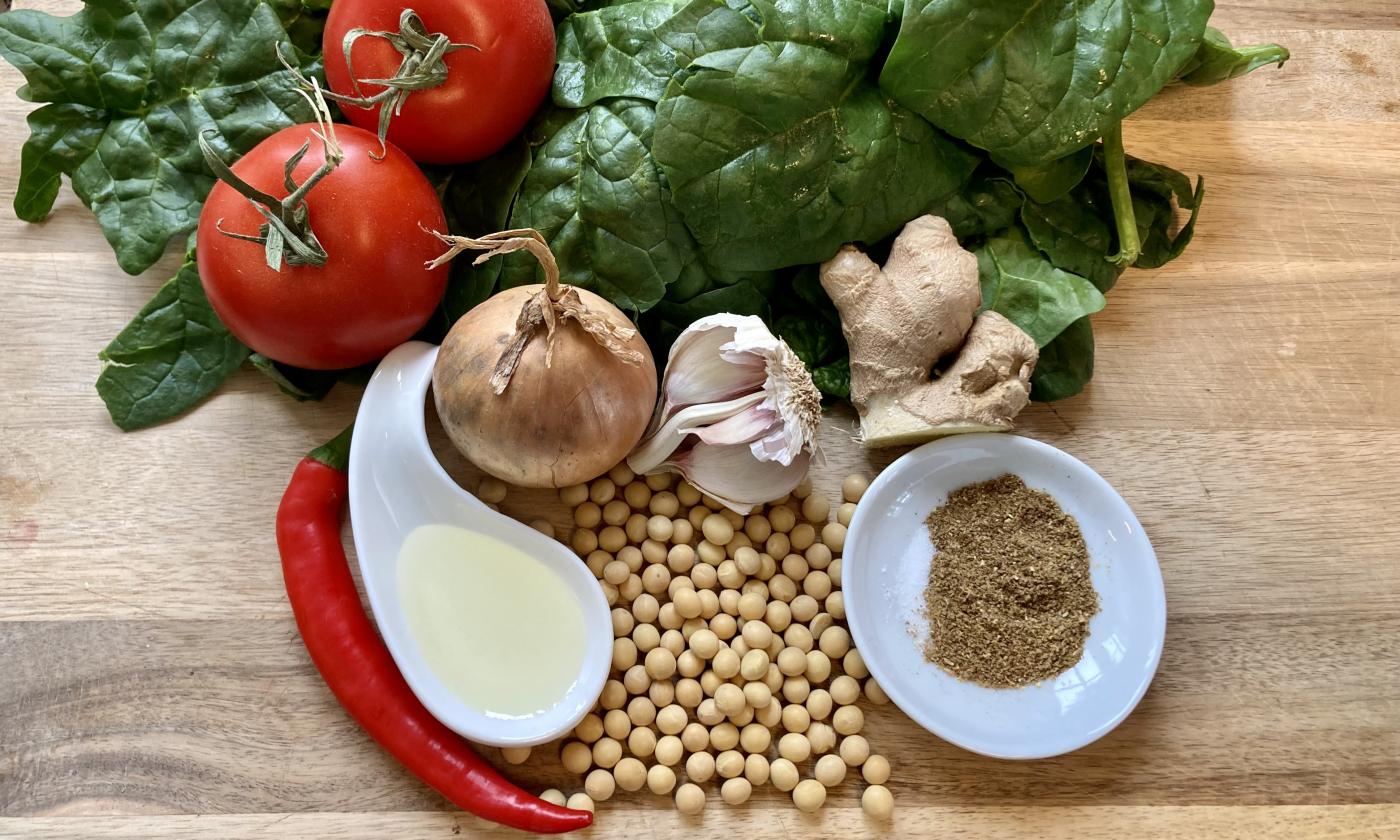Soybeans with spinach Indian style
vegan
Ingredients (for servings, )
| 8 ½ oz | Soybeans, ripe seeds, raw (organic?) |
| 800 ml | Drinking water, raw (organic?) (28 oz) |
| 1 | Onions, raw (organic?) (3.9 oz) |
| 2 cloves | Garlic (organic?) (0.21 oz) |
| 1 cm | Ginger, raw (organic?) (0.38 oz) |
| 1 | Chili peppers, red, raw (organic?) (0.18 oz) |
| 1 tbsp | Rapeseed oil, refined (organic?) (0.49 oz) |
| 2 tsp | Garam Masala (spice mix, raw?, organic?) (0.14 oz) |
| 14 oz | Spinach, raw (vegetable spinach) |
| 2 | Tomatoes, raw (organic?) (8.6 oz) |
| 1 dash | Table salt (table salt, raw?, organic?) (0.01 oz) |
Equipment
- hand-held blender / immersion blender
- grater
- stove
- saucepan
- sieve
Type of preparation
- cook
- chop or grind
- soak
- sauté
- sweat
- season to taste
- purée
- remove the skin
- peel
- grate (shred)
Preparation
preparation the day before
Soak the soybeans in plenty of water for about 24 hours. Then drain and rinse. Cook the soybeans in lightly salted water (or broth) for 80-90 minutes.By using a pressure cooker you can reduce the cooking time to about 25 minutes.
In the meantime, start with the next step.For the spinach
Peel and dice the onion and garlic. Cut the chili into slices. Peel and grate the ginger. Wash the spinach and remove the stem ends. Wash the tomatoes, remove the stalks and then dice finely. Heat the rapeseed oil in a large pot with a lid.First, sauté the onions for about 2 minutes, then add the garlic, chili, ginger and garam masala and stir. Add the washed spinach (it doesn't matter if a little water gets into the pot). Cover and simmer for about 3-5 minutes. Then puree with a hand blender. You don't have to puree everything finely, there can still be some pieces left. Add the diced tomatoes and mix in.
Completing the dish
Add the cooked and drained soybeans to the spinach. Season with salt and chili and optionally lemon juice.
|
Nutritional Information per person
Convert per 100g
|
2000 kcal | |
|---|---|---|
| Energy | 364 kcal | 18.2% |
| Fat/Lipids | 17 g | 23.8% |
| Saturated Fats | 2.2 g | 10.9% |
| Carbohydrates (inc.dietary fiber) | 29 g | 10.8% |
| Sugars | 8.2 g | 9.2% |
| Fiber | 9.5 g | 38.0% |
| Protein/Albumin | 27 g | 53.6% |
| Cooking Salt (Na:135.0 mg) | 343 mg | 14.3% |
| Essential micronutrients with the highest proportions | per person | 2000 kcal | |
|---|---|---|---|
| Vit | Vitamin K | 521 µg | 695.0% |
| Vit | Vitamin B9, B11 (Folate, as the active form of folic acid) | 443 µg | 222.0% |
| Prot | Tryptophan (Trp, W) | 0.42 g | 169.0% |
| Min | Manganese, Mn | 2.8 mg | 138.0% |
| Prot | Threonine (Thr, T, irreversibly transaminated) | 1.3 g | 135.0% |
| Min | Copper, Cu | 1.3 mg | 126.0% |
| Prot | Isoleucine (Ile, I) | 1.4 g | 113.0% |
| Prot | Lysine (Lys, K, irreversibly transaminated) | 1.9 g | 102.0% |
| Elem | Potassium, K | 1'912 mg | 96.0% |
| Prot | Leucine (Leu, L) | 2.3 g | 96.0% |
Detailed Nutritional Information per Person for this Recipe
The majority of the nutritional information comes from the USDA (US Department of Agriculture). This means that the information for natural products is often incomplete or only given within broader categories, whereas in most cases products made from these have more complete information displayed.
If we take flaxseed, for example, the important essential amino acid ALA (omega-3) is only included in an overarching category whereas for flaxseed oil ALA is listed specifically. In time, we will be able to change this, but it will require a lot of work. An “i” appears behind ingredients that have been adjusted and an explanation appears when you hover over this symbol.
For Erb Muesli, the original calculations resulted in 48 % of the daily requirement of ALA — but with the correction, we see that the muesli actually covers >100 % of the necessary recommendation for the omega-3 fatty acid ALA. Our goal is to eventually be able to compare the nutritional value of our recipes with those that are used in conventional western lifestyles.
| Essential fatty acids | per person | 2000 kcal |
|---|---|---|
| Alpha-Linolenic acid; ALA; 18:3 omega-3 | 1.3 g | 65.0% |
| Linoleic acid; LA; 18:2 omega-6 | 5.3 g | 53.0% |
| Essential amino acids | per person | 2000 kcal |
|---|---|---|
| Tryptophan (Trp, W) | 0.42 g | 169.0% |
| Threonine (Thr, T, irreversibly transaminated) | 1.3 g | 135.0% |
| Isoleucine (Ile, I) | 1.4 g | 113.0% |
| Lysine (Lys, K, irreversibly transaminated) | 1.9 g | 102.0% |
| Leucine (Leu, L) | 2.3 g | 96.0% |
| Phenylalanine (Phe, F) | 1.5 g | 96.0% |
| Valin (Val, V) | 1.5 g | 91.0% |
| Methionine (Met, M) | 0.40 g | 43.0% |
| Vitamins | per person | 2000 kcal |
|---|---|---|
| Vitamin K | 521 µg | 695.0% |
| Vitamin B9, B11 (Folate, as the active form of folic acid) | 443 µg | 222.0% |
| Vitamin B7 (Biotin, ex vitamin H) | 48 µg | 96.0% |
| Vitamin A, as RAE | 506 µg | 63.0% |
| Vitamin B1 (Thiamine) | 0.67 mg | 61.0% |
| Vitamin C (ascorbic acid) | 45 mg | 56.0% |
| Vitamin B2 (Riboflavin) | 0.76 mg | 54.0% |
| Vitamin B6 (pyridoxine) | 0.55 mg | 39.0% |
| Vitamin E, as a-TEs | 4.1 mg | 34.0% |
| Vitamin B3 (Niacin) | 2.2 mg | 14.0% |
| Vitamin B5 (Pantothenic acid) | 0.67 mg | 11.0% |
| Essential macroelements (macronutrients) | per person | 2000 kcal |
|---|---|---|
| Potassium, K | 1'912 mg | 96.0% |
| Phosphorus, P | 516 mg | 74.0% |
| Magnesium, Mg | 268 mg | 71.0% |
| Calcium, Ca | 305 mg | 38.0% |
| Sodium, Na | 135 mg | 17.0% |
| Essential trace elements (micronutrients) | per person | 2000 kcal |
|---|---|---|
| Manganese, Mn | 2.8 mg | 138.0% |
| Copper, Cu | 1.3 mg | 126.0% |
| Iron, Fe | 13 mg | 95.0% |
| Zinc, Zn | 3.9 mg | 39.0% |
| Selenium, Se | 13 µg | 23.0% |
| Iod, I (Jod, J) | 17 µg | 11.0% |
| Fluorine, F | 150 µg | 4.0% |
The Indian-style soybeans with spinach are easy to prepare and very filling due to their high protein content.
Nutrient profile: According to GDA guidelines, one portion of this protein-rich dish covers several times the average daily requirement of vitamin K and folic acid and 100% of the requirement of almost all essential amino acids. However, some of the heat-sensitive ingredients such as folic acid are lost during the cooking process, which slightly reduces the amount per portion. The ratio of omega-6 to omega-3 fatty acids is 4:1, which is below the maximum recommended ratio of 5:1. You can find more information on the subject at the following link: Vegans often eat unhealthily. Avoidable nutritional errors.
Soybeans: Soybeans are very high in protein and are therefore a good vegan protein source. The ripe seeds contain all eight essential amino acids. Only the methionine content is slightly lower compared to the other seven essential amino acids, but in this dish it is still over 40% of the daily requirement per portion. The ripe seeds are not edible raw.
Spinach: Spinach is rich in vitamins (especially β-carotene, vitamin C), protein and minerals. Although spinach has a high iron content among vegetables, the iron content is not exceptionally high. Despite the high oxalic acid content, consuming raw spinach in reasonable amounts is not harmful to health.
Garam Masala: This Indian spice mixture contains black cardamom, cinnamon, cloves, black pepper and cumin, among other ingredients. Chili and coriander seeds are also often used. Unlike curry powder, it does not contain turmeric and tastes both more intense and more complex. You can buy garam masala as a spice mixture, usually in powder form, in Indian grocery stores, well-stocked supermarkets or online. Garam masala made from whole spices stays aromatic and fresh for longer. For a recipe for making your own spice mixture, please see the following link.
Yogurt: In the original Indian recipe, yogurt would be added. You can use vegan yogurt or simply add a splash of lemon juice, which will add a hint of acidity and freshness to the dish.






